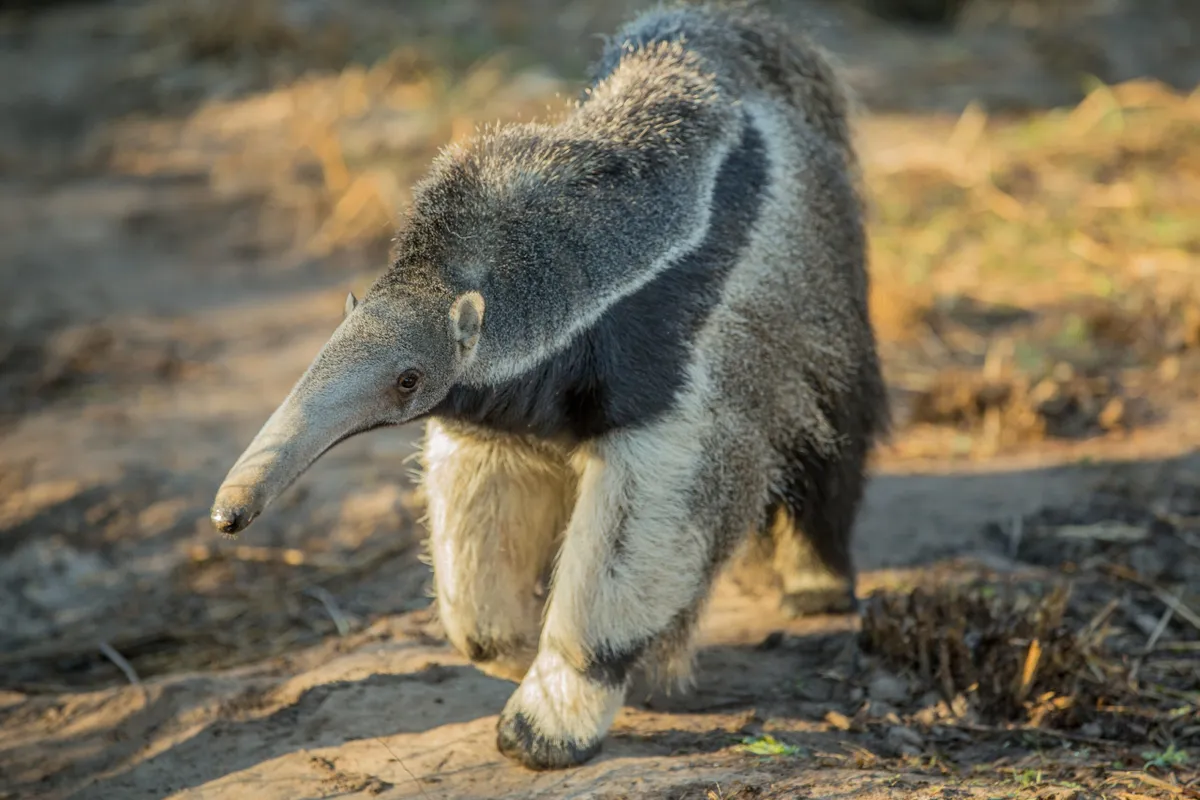Wildlife camera traps have recorded footage of a giant anteater (Myrmecophaga tridactyla) wandering through scrubland in Espinilho State Park in Rio Grande do Sul, Brazil.
It is the first time since the 1890s that this large mammal has been seen in the south-west of Rio Grande do Sul state. Experts think the anteater came from Iberá, where a major rewilding project has been underway since 2007.
The next step for researchers is to gather more data on the dispersal of the giant anteater in the region.
The anteater was spotted by Brazilian biologist Fábio Mazim as he was reviewing hundreds of hours of footage for an Instituto Pró-carnívoros wildlife survey.
Mazim and his colleagues confirmed the discovery with several videos recorded over a six-month period.
"The animal seems to be in very good condition and established in the area,” says Mazim.
“At the moment it is impossible for us to determine if it is male or female, one or even several different individuals.”
According to WWF Brazil, the species was once present in all 27 Brazilian states. It is now at threat of extinction in all regions of the country and has been lost from some states entirely. The main cause of the population decline is the degradation and loss of habitats. Hunting, road accidents and forest fires also play a part.
- How long is an anteater's tongue?
- 10 of the rarest animals in the world
- 15 weirdest animals: meet the oddballs of the natural world
Where did the giant anteater come from?
Most experts – including Flávia Miranda, president of the Tamandua Institute and a veterinarian who has been studying the species for 25 years – believe that the anteater came from Iberá in Argentina: "It is almost certain that this animal has dispersed from the province of Corrientes, in Argentina, as part of the population reintroduced in the Iberá wetlands; the geographical proximity and the morphological characteristics we observed in the animal lead us to this conclusion."
Giant anteaters were first reintroduced to Argentina’s Iberá Park in 2007 by Rewilding Argentina, the offspring organisation of Tompkins Conservation. Much like giant anteaters in Brazil, the species has been in decline in Argentina for decades due to widespread habitat loss from deforestation and industrial agriculture, poaching and motor vehicle accidents. They're also vulnerable to attacks by dogs. Since the start of the reintroduction program, 110 anteaters have been rescued and released and several generations now live in Iberá's wetlands.

The sighting in Brazil’s Rio Grande do Sul state, along with additional sightings over a 100-kilometre range, prove that Iberá's growing population of giant anteaters is colonising other regions.
Sebastian Di Martino, director of conservation for Rewilding Argentina, says: "Iberá went from a place of massive defaunation to abundance. Rewilding multiple species is making it once again a functional ecosystem. We hope that these results are inspiring for rewilding initiatives everywhere. Now, through natural dispersal or assisted translocation, Iberá can serve as a source of species for the greater region beyond Argentina experiencing massive biodiversity loss."
Kristine Tompkins, president and co-founder of Tompkins Conservation, adds: "The discovery of this giant anteater in the Espinilho State Park demonstrates that the recovery of nature is possible through rewilding. We must remember that wildlife does not recognize borders and make every effort between countries to ensure the success of large-scale restoration initiatives."
The future for giant anteaters in Brazil
Flávia Miranda believes that the giant anteater sighting in Rio Grande do Sul state "is the beginning of the species' dispersal in southern Brazil and probably also in Uruguay."
"It is important to simulate hypothetical dispersal scenarios for the years ahead. For the next stage of the project, we intend to gather more information about the species in Rio Grande do Sul. Using camera traps, we will try to find out if there are more individuals in the area. We will also try and determine what the habitat is like that they have chosen to live in.
"Furthermore, we intend to capture the individual sighted in Espinilho State Park, collect biological samples for health and mainly genetic analysis, and compare them with the populations that exist elsewhere in Brazil. We will also place a radio collar on the individual to assess the home range and space used by the species in this biome.
"The project has been designed to help us evaluate the impact of the arrival of this specific population in Brazil. In a few years, these artificial populations will meet natural populations – this scenario could be positive or negative, depending on how they react to each other. We are trying to understand the whole picture so that the negative impacts are as minimal as possible."

Giant anteaters in Iberá Park
With its long tongue, unusual snout, muscular legs and chunky tail, the giant anteater is one of the most striking animals in Argentina. But it’s also one of the county’s most at risk.
Rewilding Argentina is working to strengthen their population once more. Since the anteater reintroduction program began in 2007, more than 100 anteaters have been rescued and released in Iberá Park, a vast area of wetland, Paraná Atlantic forest, Chaco forest, open grasslands and thorny shrublands in Corrientes Province in northeastern Argentina.
The project is also working to bring back a number of other species to Iberá Park, including the jaguar, pampas deer, giant otter, red-and-green macaw, collared peccary and the bare-faced curassow.

Main image credit: Fundacion Rewilding Argentina
